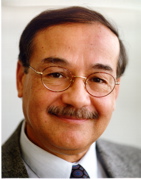Grant spurs imaging center to action
$20 million will fund CenSISS research and development

Peering beneath the surface of something can reveal things not apparent to the naked eye — from a medical diagnosis to hidden objects in a war zone to what’s in a piece of luggage. The Center for Subsurface Sensing and Imaging Systems (CenSSIS), which is working on just this kind of research, recently received a $20 million gift from the Gordon Foundation, enabling CenSSIS to grow from an academic research center into an R&D center.
Boston University is one of the institutions of higher education participating in CenSSIS, an Engineering Research Center founded in 2000 with a National Science Foundation grant. It works to improve existing technology for imaging hidden regions, such as the human body, the bottom of the sea, or the Earth. The gift from the Gordon Foundation, named after Bernard M. Gordon, founder of the Peabody, Mass., medical imaging company Analogic Corporation, and his wife, Sophia, will help CenSSIS to achieve research sustainability once the original NSF grant ends, in about four years.
“The partnership will be able to use the grant to attract new students at all levels, from all institutions, who want to learn engineering in a new way,” says Bahaa Saleh, chair of the College of Engineering department of electrical and computer engineering and deputy director of CenSSIS.
Part of the money will fund the Gordon Engineering Leadership Program, an intensive one-year graduate program designed to promote engineering excellence. It will begin in September 2007.
“While details remain to be settled, we anticipate that Gordon fellows will combine strong technical expertise with an understanding of how research ideas best are converted into useful products and services to society,” says Michael Ruane, an ENG professor of electrical and computer engineering and BU’s leader of educational programs related to CenSSIS.
Engineering education tends toward problem-solving, but “the extra work required to translate basic research into practical solutions and designs is seldom done in academia,” says David Castanon, an ENG professor of electrical and computer engineering and assistant director of CenSISS. “Attacking such problems requires an integration of multiple disciplines that crosses beyond the barriers of our academic degree programs.”
For example, CenSISS took a technique used to create a mosaic ¬of the Titanic — 756 high-resolution pictures through miles of water — and applied it to mapping the retina for laser surgery and for 3-D imaging of neurons.
The founding partners in CenSSIS are lead institution Northeastern University, BU, Rensselaer Polytechnic Institute, and the University of Puerto Rico, Mayaguez. There are 12 professors and 40 students from the College of Engineering at BU participating in CenSSIS.